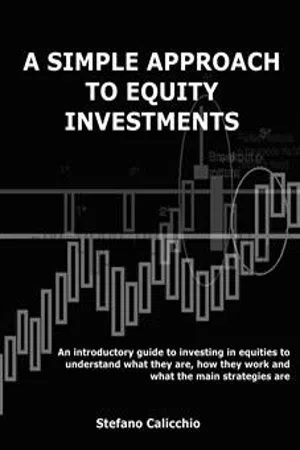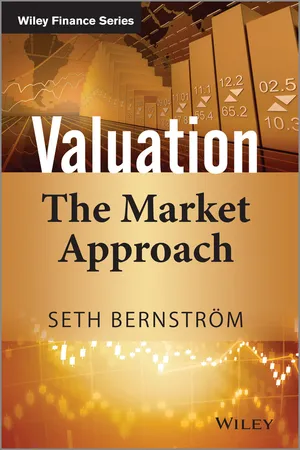Business
Market Capitalization
Market capitalization refers to the total value of a company's outstanding shares of stock. It is calculated by multiplying the current stock price by the total number of outstanding shares. Market capitalization is used to determine the size and value of a company and is a key metric for investors and analysts when evaluating investment opportunities.
Written by Perlego with AI-assistance
Related key terms
3 Key excerpts on "Market Capitalization"
- eBook - ePub
A simple approach to equity investing
An introductory guide to investing in equities to understand what they are, how they work and what the main strategies are
- Stefano Calicchio(Author)
- 2022(Publication Date)
- Stefano Calicchio(Publisher)
The price of a particular share is, in short, a true indicator of a company's valuation. If you add up the value of all issued shares, you get the market capitalisation of a company. For example, a company that has issued 200000 shares at a price of 200 dollars will have a capitalisation of 40 million dollars.Market capitalisation is a good indicator of the size of the company and can be used to make comparisons between different companies. It also represents the amount of money potentially needed to buy a company, although it does not necessarily correspond to the intrinsic value of the company. In addition, capitalisation can determine the entry of the company into specific sectoral indices, such as those dedicated to small-caps, mid-caps or large-caps.The market capitalisation of a company increases or decreases according to the movements of its shares. In addition, companies can also increase the value of their market-cap by issuing new shares.Returning to the price of individual shares, supply and demand determine their performance during market openings. The difference between these two parameters is called the spread: the narrower it is, the more liquid the stock is. Conversely, the wider this difference is, the more illiquid the stock is considered to be.Understanding these parameters and their inevitable implications is not only a theoretical issue, but also has important operational implications. - eBook - ePub
Valuation
The Market Approach
- Seth Bernstrom(Author)
- 2014(Publication Date)
- Wiley(Publisher)
Chapter 5
Market Value of Equity vs. Market Value of Operating/Invested Capital
What is to be valued: the equity capital or the operating/invested capital?5.1 MARKET VALUE OF EQUITY
The equity market value or, alternatively, the market value of all outstanding shares (the Market Capitalization for companies listed on a stock exchange) is generally represented by the letter P (Price).5.2 MARKET VALUE OF OPERATING/INVESTED CAPITAL
The market value of operating capital or, alternatively, the market value of invested capital, refers to the market value of the business operations as a whole (i.e. the entire capital structure, not just the market value of the equity as above), and so represents the value of the business enterprise in its entirety.When applying the market approach, the market value of operating/invested capital is usually expressed using one of the following three terms: EV (enterprise value), MVIC (market value of invested capital) or PA (price assets). Consequently, when the enterprise value (i.e. the EV) of a company is referred to here, it refers to the market value of its operating/invested capital. Figure 5.1 illustrates the link between the market value of operating/invested capital, i.e. the enterprise value, on the asset side and the market value of operating/invested capital, i.e. the enterprise value, on the liability side (note: from now on, the terms “operating capital” and “invested capital” are interchangeable).1Figure 5.1 - eBook - ePub
Private Equity
Transforming Public Stock to Create Value
- Harold Bierman(Author)
- 2011(Publication Date)
- Wiley(Publisher)
In some situations the only completely objective value measure is the Market Capitalization. This is equal to the number of outstanding shares of common stock times the market price per share, assuming the market price is observable and there are no complexities in computing the number of outstanding shares. Any acquirer would have to expect to pay a premium to the current Market Capitalization. The market value of the common stock sets a floor for an offering price by a buyer. Rarely would a buyer consider submitting a bid less than current market price and expect to acquire a majority of the outstanding shares. In fact, one would expect the acquirer to have to pay a premium over the market price. Thus the market price of the common stock is an important measure of value since it sets a minimum-offering price.It can be argued that, with a closely held corporation, if the stockholders desire to unload their stock, they may not be able to, because the market is too thin. In such a situation the seller might accept the market price or even marginally less than the market price, since the market price does not fairly represent the firm’s value.Can one obtain the value of the stockholders’ equity by using the market value for a few shares traded on the stock market? It should be remembered that the entire universe of investors is available as possible purchasers of the stock and that the present owners are not bidding up the stock price to acquire more shares. Normally it will not take a large price increase to cause the present investors to sell their shares of stock assuming the price before the bid was set by the market. Premiums paid by the acquirers in most deals are less than .30.MULTIPLIERSThe use of multipliers for valuation is common practice. A multiplier is applied to some type of flow measure. The multiplier is frequently based on the observed relationships of comparable firms. The following multipliers are used:
Index pages curate the most relevant extracts from our library of academic textbooks. They’ve been created using an in-house natural language model (NLM), each adding context and meaning to key research topics.


